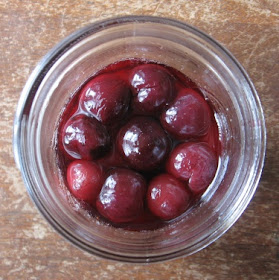
So. This weekend
Veronica and I made maraschino cherries.
While researching recipes online, I noticed the vast majority of resources were concerned not only with making cherries, but showing just how awful the canned version is. Well, that's no surprise, is it? The unnatural red color, verging on fluorescence, the sticky, unpleasant aftertaste (and just taste) of corn syrup, the fact that even an opened jar won't go bad in over a year--none of these are signs of great purity or authenticity. Any homemade cherries would clearly be far superior.
Veronica also had a bottle of Luxardo maraschino liqueur sitting unused at her house. What better use for it than homemade cherries?
We decided to use
this maraschino cherry recipe from The Cupcake Project. Are these actually authentic maraschino cherries? Honestly, I don't know--I couldn't find the original Imbibe Magazine recipe (though their
brandied cherries recipe looks oddly similar!)--but they're obviously better than their mass-marketed counterpart. They're easy to make, and call for the big, sweet cherries that are actually available in our farmer's market. (In my experience, tart cherries just don't exist in California--sad but true.) They also don't require canning, which was perfect for our small test batch.
Maraschino cherries1 pound sweet cherries
1/2 cup sugar
1/2 cup water
2 tsp lemon juice (from a lemon, not a jar)
1 cinnamon stick
1 tsp vanilla extract
pinch of nutmeg
1 cup maraschino liqueur
We used about 3/4 pound of cherries, since that's all we had after pooling our supplies. Veronica pitted all of them with a knife; a cherry pitter would certainly have been faster and neater, but who can justify actually buying yet another piece of one-use kitchen equipment? I suppose it depends on the quantity of jam, preserves, pie, and liquor-infused cherries you want to make every summer.
Ok. Make a syrup with all your ingredients but the cherries and maraschino. Bring everything to a boil; note the excellent aromas rising from your pan. Add your cherries, reduce the heat, and simmer for about 5-7 minutes. In the course of cooking, the cherries will leach some of their juice into the syrup, turning it dark red. Pretty!

When cooked, turn off the heat. Add the maraschino liqueur to the cherries; stir. Ladle the cherries and syrup (er, liquor?) into jars. Let them cool; lid them; store them in the refrigerator.
When immediately done, the cherries will smell strongly of maraschino liqueur and not much else. It's pretty pungent. Clearly, the best course of action is to let them age and cure a bit before eating. Er, garnishing. Drinking. Maybe in a week or so they'll be ready for us to embark on a manhattan- and old-fashioned-based taste test.